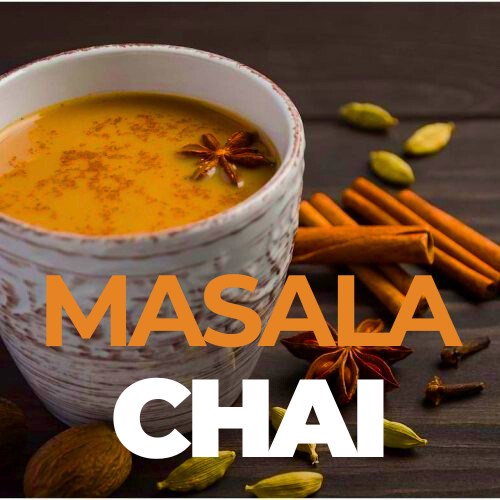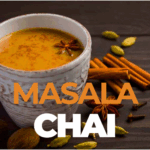What is the Difference Between Spiced Chai and Masala Chai?
What is the difference between spiced chai and masala chai? In the world of tea, few beverages evoke as much warmth and comfort as chai. From bustling streets in Mumbai to trendy cafes in New York, chai has transcended its cultural roots and become a beloved drink worldwide. But as chai’s popularity grows, so does the confusion surrounding its terminology — particularly between “spiced chai” and “masala chai.”
Are they the same thing? Is one more authentic than the other? And what about the ever-popular “chai latte”? In this definitive guide, we’ll demystify the differences between spiced chai and masala chai, delve into their origins, explore their ingredients, and help you choose which version might suit your taste buds best.
Understanding Chai: A Brief Overview
Before diving into the differences, it’s important to understand what “chai” means. In many languages, including Hindi, Russian, and Mandarin, “chai” simply means “tea.” In India, the term “chai” often refers to a specific preparation — black tea brewed with milk, sugar, and spices.
However, in Western countries, “chai” is commonly shorthand for the spiced Indian tea blend known as masala chai. The phrase “spiced chai” has emerged in English-speaking regions as a marketing term, sometimes used interchangeably with masala chai, but often with subtle differences.
What is Masala Chai?
Origin of Masala Chai
Masala chai traces its roots back to India, where tea became a popular beverage in the 20th century, largely due to British colonial influence and the establishment of the Indian tea industry. However, Indians adapted tea to suit local tastes by adding milk, sugar, and a variety of indigenous spices, creating what we now know as masala chai.
Meaning of “Masala”
“Masala” is a Hindi word that translates to “spice blend.” Thus, masala chai literally means “spiced tea.”
Key Ingredients in Masala Chai
While recipes vary by region and household, traditional masala chai typically includes:
- Black tea (often Assam or Darjeeling)
- Milk (whole milk is traditional, but plant-based alternatives are also used)
- Sweetener (sugar or jaggery)
- Spices, commonly:
- Cardamom
- Cinnamon
- Ginger
- Cloves
- Black pepper
Some variations include nutmeg, fennel, star anise, or saffron.
Preparation of Masala Chai
The authentic method of making masala chai involves simmering loose black tea leaves with milk, water, sweeteners, and freshly ground spices. This boiling process melds the flavors into a rich, aromatic, and robust beverage.
What is Spiced Chai?
The Emergence of “Spiced Chai”
The term spiced chai is a more modern, Western invention. As masala chai gained popularity globally, cafes and tea brands adapted it to local palates. In this context, “spiced chai” often refers to a pre-mixed blend of black tea and spices, sold as tea bags or concentrates.
Key Characteristics of Spiced Chai
- Commercial Blends: Many spiced chai products are standardized blends, sometimes containing only a few spices for convenience.
- Less Traditional: Often tailored to Western tastes, with more emphasis on sweetness and vanilla flavors.
- Preparation: Typically brewed like regular tea or mixed with steamed milk to make a “chai latte.”
Is Spiced Chai Authentic?
While spiced chai is inspired by masala chai, it often lacks the complexity, freshness, and traditional preparation methods associated with authentic Indian masala chai.
Key Differences Between Spiced Chai and Masala Chai
| Feature | Masala Chai | Spiced Chai |
|---|---|---|
| Origin | India | Western adaptation |
| Meaning | “Masala” = spice blend, “chai” = tea | “Chai” = tea, “spiced” refers to added spices |
| Preparation | Simmered with whole spices, tea, milk, sugar | Often pre-blended, brewed like regular tea |
| Spice Profile | Varies regionally; complex and aromatic | Simplified, often with vanilla or added sweeteners |
| Cultural Significance | Integral to Indian culture and daily life | Popular cafe beverage, less cultural depth |
| Common Use | Homemade, street vendors (chaiwalas) in India | Cafes, coffee shops, commercial products |
Why the Confusion?
The confusion arises primarily from language and marketing:
- Redundancy: “Chai” already means “tea.” So “spiced chai” technically means “spiced tea tea.”
- Commercialization: Brands use “spiced chai” to evoke exoticism and market it to consumers unfamiliar with “masala chai.”
- Chai Latte: The popular cafe drink combines spiced chai concentrate with steamed milk, further blurring distinctions.
The Role of Chai Latte in the Mix
A chai latte is typically made by combining spiced chai concentrate with steamed milk, mimicking the creaminess of masala chai but often lacking its robust spice profile. It’s generally sweeter, less spicy, and more milk-forward than traditional masala chai.
Key takeaway: While masala chai is the inspiration behind spiced chai and chai lattes, the preparation and experience differ significantly.
Regional Variations of Masala Chai in India
India’s diverse regions boast unique chai recipes:
- Kolkata Chai – Often served in earthen cups (kulhads), with a lighter use of spices.
- Mumbai Cutting Chai – Small, strong servings with pronounced ginger and cardamom flavors.
- Kashmiri Kahwa – A green tea-based spiced drink with saffron, almonds, and cinnamon.
- South Indian Chai – Sometimes flavored with local spices like star anise and more milk.
Each variation showcases the adaptability of chai within different cultural contexts.
Popular Spices in Chai and Their Benefits
Cardamom
- Flavor: Sweet, floral.
- Benefits: Aids digestion, breath freshener.
Ginger
- Flavor: Spicy, warming.
- Benefits: Anti-inflammatory, relieves nausea.
Cinnamon
- Flavor: Sweet, woody.
- Benefits: Blood sugar regulation, antioxidant-rich.
Cloves
- Flavor: Pungent, slightly bitter.
- Benefits: Analgesic, antimicrobial.
Black Pepper
- Flavor: Pungent, sharp.
- Benefits: Enhances nutrient absorption, aids digestion.
Health Benefits of Masala Chai vs. Spiced Chai
Both masala chai and spiced chai may offer health benefits due to their use of spices with medicinal properties. However, traditional masala chai, made with fresh spices, may confer greater benefits compared to mass-produced spiced chai blends that often contain artificial flavors and excess sugars.
How to Make Authentic Masala Chai at Home
Ingredients:
- 1 cup water
- 1 cup milk
- 2 tsp loose black tea (Assam)
- 2-3 green cardamom pods
- 1 small cinnamon stick
- 3-4 cloves
- A few slices of fresh ginger
- Sugar to taste
Instructions:
- Crush the spices gently.
- Boil water with spices for 3-5 minutes.
- Add tea leaves; simmer for 2 minutes.
- Add milk and sugar.
- Simmer for another 2-3 minutes.
- Strain and serve hot.
Tip: Adjust spice proportions to suit your taste.
Can Spiced Chai Be as Good as Masala Chai?
While convenient, pre-made spiced chai blends often lack the depth and richness of freshly made masala chai. However, premium artisanal spiced chai blends can come close. The choice ultimately depends on personal preference and lifestyle.
Chai in Popular Culture
The rise of spiced chai and chai lattes in the West is closely linked to the specialty coffee movement. Chains like Starbucks popularized the “chai tea latte”, making it a staple menu item. This commercialization, while spreading awareness, has also diluted the traditional preparation and meaning of masala chai.
Is There a Right or Wrong Way to Make Chai?
No! While purists advocate for the traditional method, chai has always been a beverage of adaptation. Whether you prefer the robust masala chai simmered in a pot or the convenience of a spiced chai latte, the most important factor is enjoyment.
Summary: The Essential Differences
- Masala chai is the authentic Indian spiced tea, prepared by simmering spices, black tea, milk, and sugar.
- Spiced chai is a Western adaptation, often a pre-blended tea marketed for convenience.
- The chai latte is an additional evolution, more akin to spiced chai with steamed milk.
- Authentic masala chai offers more cultural depth and a complex flavor profile.
FAQs About Spiced Chai vs. Masala Chai
(SEO-optimized for search intent)
1. What’s the main difference between spiced chai and masala chai?
The primary difference lies in origin and preparation. Masala chai is a traditional Indian beverage made by simmering black tea with fresh spices, milk, and sugar. Spiced chai, on the other hand, is a Western term for pre-blended tea with added spices, often brewed like regular tea.
2. Is spiced chai the same as chai latte?
Not exactly. Spiced chai refers to a tea blend with spices, while a chai latte typically uses a spiced chai concentrate mixed with steamed milk. A chai latte is creamier and often sweeter than plain spiced chai.
3. Can I make masala chai with spiced chai tea bags?
You can, but it won’t be the same. Tea bags may lack the freshness and complexity of whole spices. For authentic masala chai, it’s better to use loose tea and freshly ground spices.
4. What spices are in masala chai?
Common spices include cardamom, ginger, cinnamon, cloves, and black pepper. Variations might include nutmeg, fennel, or saffron depending on regional preferences.
5. Is masala chai healthier than spiced chai?
Masala chai made with fresh spices may offer more health benefits due to higher levels of essential oils and antioxidants. Some commercial spiced chai products contain added sugars and artificial flavors, which may reduce their healthfulness.
6. Why do people say “chai tea”? Isn’t that redundant?
Yes, it is redundant. “Chai” means “tea” in several languages. The phrase “chai tea” emerged in Western countries to specify the spiced Indian-style beverage, but technically it translates to “tea tea.”
7. Can you make masala chai without milk?
Yes. While traditional masala chai uses milk, you can make it without or use plant-based alternatives like oat, almond, or soy milk.
8. Which is stronger: spiced chai or masala chai?
Masala chai typically has a stronger, more robust flavor due to the simmering process and use of fresh spices. Spiced chai blends are often milder, depending on the brand and preparation.
9. Is masala chai caffeinated?
Yes, masala chai is caffeinated because it uses black tea as a base. The caffeine content varies depending on the amount of tea used and the brewing time.
10. Can you buy authentic masala chai in stores?
Some specialty tea shops and online retailers offer authentic masala chai blends. However, for the freshest and most traditional experience, making it at home with loose tea and whole spices is recommended.
Conclusion
The difference between spiced chai and masala chai is nuanced but significant. Masala chai is a traditional, culturally rich Indian beverage with a complex flavor profile, prepared through simmering tea with milk and spices. Spiced chai is a convenient, often commercialized version of this drink, tailored for modern consumption.
Whether you enjoy a quick spiced chai latte from your favorite cafe or take the time to prepare traditional masala chai at home, both offer delightful experiences in their own right. Understanding their differences allows you to appreciate the heritage behind each cup.
Want to Try Authentic Masala Chai?
Check out our masala chai recipe above or explore local Indian restaurants and tea shops to experience the authentic flavors for yourself!
If you enjoyed this guide, share it with a fellow tea lover or bookmark it for your next cozy tea session!





